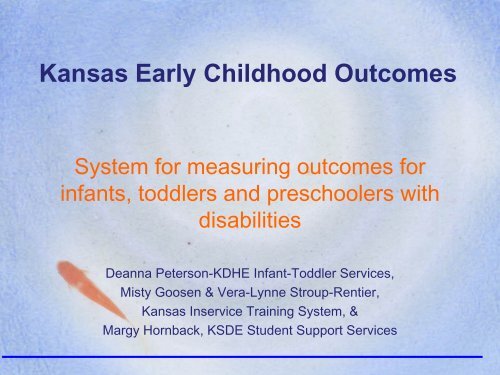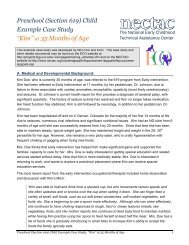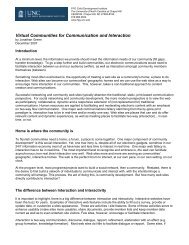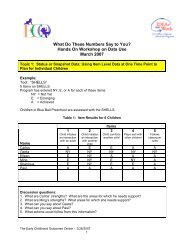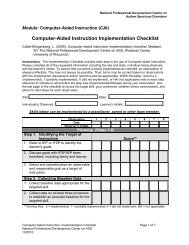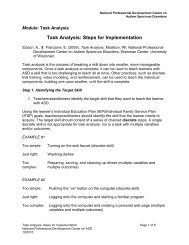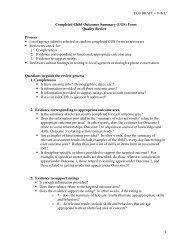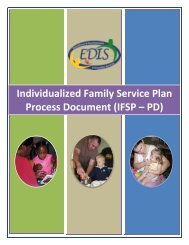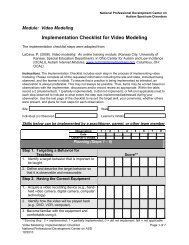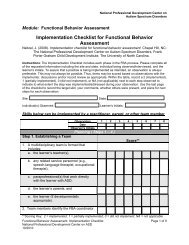Kansas Early Childhood Outcomes - FPG Child Development Institute
Kansas Early Childhood Outcomes - FPG Child Development Institute
Kansas Early Childhood Outcomes - FPG Child Development Institute
You also want an ePaper? Increase the reach of your titles
YUMPU automatically turns print PDFs into web optimized ePapers that Google loves.
<strong>Early</strong> <strong><strong>Child</strong>hood</strong><strong>Outcomes</strong>Overview
Pressure for accountability atthe Federal level• Office of Management and Budget(OMB) uses a tool (PART - ProgramAssessment Rating Tool) to reviewfederal programs• Four critical Assessment Areasincluding “results and accountability”• Programs given ratings from ineffectiveto effectivePurpose – “to enhance budget analysis”
PART evaluation: Findings andrecommendations• Part C and 619 Findings: No long-term childoutcome goals or data• The Program Assessment Rating Tool (PART)required the Department to:1. Establish long-term outcome-oriented objectives2. Develop a strategy to collect performance dataOffice of Special Education Programs (OSEP)asked states to provide outcome data in theirAnnual Performance Reports (APRs)
OSEP asks states to provide outcomedata and develop strategies to do this…• Everyone wants to know “How arechildren doing?” but need to decide“with regard to what?”• Outcome areas to be addressed:–<strong>Child</strong>– Family
RecommendationAll child outcomes apply to bothPart C and 619 (i.e., children birthto five years of age)
What did <strong>Kansas</strong> decide to do?• State decided to work with the ECO group,because of the short time lines states were underto come up with a valid and reliable way ofmeasuring child outcomes.• A stakeholders group was put together fromKSDE, KDHE, Special Ed. Directors, NetworkCoordinators and other state early childhoodstakeholders to form a birth to 5 initiative inaddressing child outcomes
Through thoughtful stakeholder discussionand input, the following was decided…Functional outcomes• Looked at best practice (i.e. the kind of outcomesrecommended for IFSPs and IEPs)• Looked at our own state system of local control andthe diverse programs in <strong>Kansas</strong>.• Surveyed all programs on the assessment toolscurrently used and 8 assessment tools wereidentified.
The approved curriculumbased assessments (CBAs)• Assessment and Evaluation Programming System(AEPS)• Carolina Curriculum• Creative Curriculum• Hawaii <strong>Early</strong> Learning Profile (HELP)• High Scope <strong>Child</strong> Observation Record• Individual Growth and <strong>Development</strong> Indicators(IGDIs)• Transdisciplinary Play-Based Assessment• Work Sampling System (WSS)
Transition to a CBA• LEAs & ITNs not currently using one ofthe CBAs listed will have a transitionperiod from April 2006-April 2007• This allows programs time to adopt oneof the eight approved CBA and trainstaff on its use
Transition to a CBATransition list of assessments you canuse in the interim are:– Weschler Primary and Preschool Scale ofIntelligence-Revised– Stanford Binet Scale of Intelligence– Woodcock Johnson III– Bayley Scales of Infant <strong>Development</strong>– Battelle <strong>Development</strong>al Inventory– Differential Ability Scales
Reporting requirementPercent of infants and toddlers with IFSPsand preschooler’s with IEPs whodemonstrate improved:1. Positive social-emotional skills (includingsocial relationships)2. Acquisition and use of knowledge andskills (including early language/literacy andcommunication)3. Use of appropriate behaviors to meet theirneeds
OSEP child outcome reportingrequirements• % of infants and toddlers/preschoolerswho reach or maintain functioning at alevel comparable to same-age peers• % of infants and toddlers/preschoolerswho improve functioning• % of infants and toddlers/preschoolerswho did not improve functioning
Timelines for reporting data*December 2005: Plan for measuring childoutcomesFebruary 2007: Report status on entry (entrydata only)February 2008: 1st time to report progress dataFebruary 2009: 2nd time to report progress dataFebruary 2010: 3rd time to report progress data*See handout
<strong>Early</strong> <strong><strong>Child</strong>hood</strong><strong>Outcomes</strong>The Big Picture
What is an early childhoodoutcome?An “outcome” is defined as a benefitexperienced as a result of services andsupports received. Thus, an outcome isneither the receipt of services norsatisfaction with services, but rather whathappens as a result of services providedto children.» <strong>Early</strong> <strong><strong>Child</strong>hood</strong> <strong>Outcomes</strong> Center, April 2005
<strong>Outcomes</strong> are functional• Meaningful in the context of everydayliving• Integrated series of behaviors/skills• They are not– a single behavior– a sum of a series of discrete behaviors– domains based
Functional outcomes• Typical performance across settingsand situations• Use of skills to accomplish tasks• Not an indication of functioning underideal circumstances
<strong>Early</strong> childhood outcomes/general education curriculum• <strong>Outcomes</strong> align with general educationcurriculum for young children• Represents what children should beable to know or do across environments
The link between early childhoodoutcomes and CBAGiven the natural link between the earlychildhood outcomes and the generalcurriculum, CBA tools are a logical choicefor measuring performance within theoutcome areas.
The link between early childhoodoutcomes and present levels• What is not new– Present Levels of <strong>Development</strong> (Part C) andPresent Levels of Academic Achievement andFunctional Performance (Part B)– Evaluation teams requirements• What is new– Degree and manner of collection of information– State and Federal use
<strong>Early</strong> <strong><strong>Child</strong>hood</strong><strong>Outcomes</strong>A Closer Look
Elaboration of the ECO outcomesListeningBeing curiousAttending<strong>Child</strong>ren have positivesocial relationshipsPersistingRelationshipswith groupFollowsadults rulesRelationshipswithpeersTo be active and successfulparticipants now and in thefuture in a variety of settings<strong>Child</strong>ren acquire &use knowledge &skillsSymbol use,abstractthinking<strong>Child</strong>ren takeappropriate action tomeet their needsSelf-care,health &safetyMasters theenvironmentKnowledgeof physicalworld &cultureAppliesknowledgeTouchingEngagingPracticingPlayingExploringHebbeler, K. (2005). <strong>Outcomes</strong> and evidence statements: Update from the <strong>Early</strong> <strong><strong>Child</strong>hood</strong> <strong>Outcomes</strong> Center. Presentation at OSEP’s Combined Part C/B DataMeeting in Washington, DC. Chapel Hill, NC: <strong>Early</strong> <strong><strong>Child</strong>hood</strong> <strong>Outcomes</strong> Center.
<strong>Child</strong> outcomes• Outcome Area 1: <strong>Child</strong>renhave positive socialrelationships• Outcome Area 2: <strong>Child</strong>renwill acquire and useknowledge and skills• Outcome Area 3: <strong>Child</strong>rentake appropriate action tomeet their needs
Outcome 1: <strong>Child</strong>ren havepositive social relationships (examples)• Demonstrate attachment with significantcaregivers• Initiate and maintain social interactions• Behave in a way that allowsparticipation in a variety of settings andsituations• Demonstrate trust in others
Outcome 1: <strong>Child</strong>ren have positivesocial relationships (continued)• Build and maintain relationships withchildren and adults• Regulate emotions• Understand and follow rules• Solve social problems
Outcome 2: <strong>Child</strong>ren will acquire anduse knowledge and skills (examples)• Display curiosity andeagerness for learning• Explore environment• Explore and play withpeople and objects• Engage in daily learningopportunities
Outcome 2: <strong>Child</strong>ren will acquire anduse knowledge and skills (continued)• Use vocabulary to communicate inincreasingly complex forms• Learn and use new skills in play• Acquire and use precursor skills forreading and math• Demonstrate imagination and creativityin play
Outcome 3: <strong>Child</strong>ren take appropriateaction to meet their needs (examples)• Communicate wants and needs• Meet self care needs• Participate in everyday routines andactivities• Use objects as tools in appropriate ways
Outcome 3: <strong>Child</strong>ren take appropriateaction to meet their needs (continued)• Move from place to place to participatein everyday activities, play, and routines• Seek help when necessary• Follow rules related to health and safety
<strong>Early</strong> <strong><strong>Child</strong>hood</strong><strong>Outcomes</strong>How do we do this?The <strong>Child</strong> <strong>Outcomes</strong> SummaryInformation
Key points• Assumption: <strong>Child</strong>ren can be described withregard to age expected behavior for each ofthe 3 outcomes• By definition, most children in the generalpopulation demonstrate the outcome in anage-expected way• <strong>Early</strong> intervention is designed to movechildren closer to age expected behavior• Some children will never achieve thisHebbeler, K. (2006). Using the child outcomes summary form. Presentation at <strong>Early</strong> Intervention Community in HelenaMontana. Chapel Hill, NC: <strong>Early</strong> <strong><strong>Child</strong>hood</strong> <strong>Outcomes</strong> Center.
Key points• Documenting children’s movementtoward typical development is one typeof evidence that early intervention iseffective• Documenting the extent of children’sprogress is anotherHebbeler, K. (2006). Using the child outcomes summary form. Presentation at <strong>Early</strong> Intervention Community in HelenaMontana. Chapel Hill, NC: <strong>Early</strong> <strong><strong>Child</strong>hood</strong> <strong>Outcomes</strong> Center.
Why is there a need for the <strong>Child</strong><strong>Outcomes</strong> Summary Form (COSF)?• No assessment instruments assess the 3outcomes directly• Many states will be using more than oneassessment instrument• <strong>Outcomes</strong> data will need to beaggregated across different areasHebbeler, K. (2006). Using the child outcomes summary form. Presentation at <strong>Early</strong> Intervention Community in HelenaMontana. Chapel Hill, NC: <strong>Early</strong> <strong><strong>Child</strong>hood</strong> <strong>Outcomes</strong> Center.
Features of the COSF• Not an assessment• Summarizes global sense of how the child isdoing• Rating is based on child’s functioning comparedto other children the same age• Based on child’s functioning– what child generally does across settingsand situations,– not what a child can do under idealcircumstancesHebbeler, K. (2006). Using the child outcomes summary form. Presentation at <strong>Early</strong> Intervention Community in HelenaMontana. Chapel Hill, NC: <strong>Early</strong> <strong><strong>Child</strong>hood</strong> <strong>Outcomes</strong> Center.
Summary ratings• Provide an overall sense of child’scurrent functioning in 3 areas• They are not:– Information on the services providedthemselves– The family’s satisfaction with services– An explanation of why the child’sfunctioning is at that levelHebbeler, K. (2006). Using the child outcomes summary form. Presentation at <strong>Early</strong> Intervention Community in HelenaMontana. Chapel Hill, NC: <strong>Early</strong> <strong><strong>Child</strong>hood</strong> <strong>Outcomes</strong> Center.
Summary ratings reflect globalfunctioning• Ratings on each outcome are a snapshot of:– The whole child– Functioning– Across settings and situations• Rather than:– Skill by skill– In one standardized way– Split by domainsHebbeler, K. (2006). Using the child outcomes summary form. Presentation at <strong>Early</strong> Intervention Community in HelenaMontana. Chapel Hill, NC: <strong>Early</strong> <strong><strong>Child</strong>hood</strong> <strong>Outcomes</strong> Center.
Example process for completing COSFProgram determines the procedures for when, where and howCOSF is summarized and enteredInitial information for COSF entry completedComplete and discuss screening, record review, interviews,observations and tests/assessmentsTranslate assessment information from CBA to crosswalksExamine outcomes 1, 2 and 3 and determine the child’scompetency in each areaDetermining outcome rating for outcomes 1, 2, and 3
Initial evaluation verses COSFInitial EvaluationInformation from multiplesources is encouragedComprehensiveProblem SolvingOccurs across multiple settingsCOSFInformation from multiplesources is encouragedInformation is collected foroutcomes areas only whichinclude:1.Positive socialrelationships2.Acquiring and usingknowledge and skills3.Taking appropriateactions to meet needsProblem SolvingOccurs across multiple settings
Initial evaluation verses COSFInitial EvaluationInput from childcare providers,therapists, physicians, preschoolteachers, and other caregiverswho see child across multiplesettings is vitalMultidisciplinary teamTeam members assess childDetermine eligibility for Part Cand Part B servicesCOSFInput from childcare providers,therapists, physicians, preschoolteachers, and other caregiverswho see child across multiplesettings is vitalMultidisciplinary teamOne team member can beresponsible for completing thesummary form with team’s inputDetermine outcome rating scorefor child
Initial evaluation verses COSFInitial EvaluationFamily is integral part ofassessment processCOSFFamily input is an integral part ofthis process. Family memberssee the child in situations thatprofessionals do not.Determines present levelFamily may participate indetermining the outcome ratingfor the childDiscusses present level
Example process for completing COSFProgram determines the procedures for when, where and howCOSF is summarized and enteredInitial information for COSF entry completedComplete and discuss screening, record review, interviews,observations and tests/assessmentsTranslate assessment information from CBA to crosswalksExamine outcomes 1, 2 and 3 and determine the child’scompetency in each areaDetermining outcome rating for outcomes 1, 2, and 3
Initial information for COSF entryField # Data Field # DataD1 State student ID D10 Part B entry assessmentdateD2 Legal last name D11 Part B exit assessment dateD3 Legal first name D12 Persons involved indeciding the summaryratings (name, role)D4 Legal middle nameD5 Date of birthD6 Enrollment district (Part B)D7 Network # (Part C)D8 Part C entry assessmentdateD9Part C exit assessmentdateD13Family info. on childfunctioning (Received inteam meeting; Collectedseparately; Incorporatedinto assessment(s); Notincluded)
Example process for completing COSFProgram determines the procedures for when, where and howCOSF is summarized and enteredInitial information for COSF entry completedComplete and discuss screening, record review, interviews,observations and tests/assessmentsTranslate assessment information from CBA to crosswalksExamine outcomes 1, 2 and 3 and determine the child’scompetency in each areaDetermining outcome rating for outcomes 1, 2, and 3
Translating datasources to COSFSRIOTScreening InformationRecord Review of Existing DataInterview withCaregivers and ParentsObservation in Multiple SettingsTesting Results and Crosswalks
Final questions in summary ofrelevant resultsAre we confident in the information wehave so we can begin to synthesize thisinformation concisely?
Example process for completing COSFProgram determines the procedures for when, where and howCOSF is summarized and enteredInitial information for COSF entry completedComplete and discuss screening, record review, interviews,observations and tests/assessmentsTranslate assessment information from CBA to crosswalksExamine outcomes 1, 2 and 3 and determine the child’scompetency in each areaDetermining outcome rating for outcomes 1, 2, and 3
Aligning CBA items with OSEPchild outcomes• Crosswalks are at-a-glance look atoutcomes• Expertise in child developmentFor more information contact Dr. Kristie Pretti-Frontczak, Kent State University (kprettif@kent.edu) or download acomplete version of this handout at http://fpsrv.dl.kent.edu/ecis/Web/Research/OSEP/Steps.pdf
Crosswalks• The ECO Center is in the process ofcrosswalking the most commonassessments to the 3 child outcomes• Crosswalks give a visual indication ofcoverage of the 3 outcomes• Crosswalks show which areas/subareasmap to which outcomeHebbeler, K. (2006). Using the child outcomes summary form. Presentation at <strong>Early</strong> Intervention Community in HelenaMontana. Chapel Hill, NC: <strong>Early</strong> <strong><strong>Child</strong>hood</strong> <strong>Outcomes</strong> Center.
HeathHeath is an 18 month old child with Prader Willi Syndrome.Heath was diagnosed early in infancy due to his poormuscle tone, feeding problems and body temperaturecontrol. Both of Heath’s parents work and have a strongsupport system of family and friends in their smallcommunity. Heath’s behavior is starting to be an issue forthe family as he tries to eat any small object that will fit inhis mouth, bangs his head when these small objects aretaken away or when something doesn’t go the way hedesires and is demonstrating some undesirable behavior,such as biting and spitting, toward his mother and his childcare provider.
AEPS Crosswalk Handout
Crosswalk for AEPS - Outcome 1: Positive socialemotionalskills (scored)CognitiveN • Solves common problemsSocial-CommunicationE • Turns and looks toward person speakingC • Follows person’s gaze to establish joint attentionC • Engages in vocal exchanges by babblingE • Gains person’s attention and refers to an object, person, and/or eventC • Vocalizes to express affective statesE • Recognizes own nameC • Quiets to familiar voiceN • Carries out two-step direction without contextual cuesN = Not yet; E = Emerging; S = Somewhat; C = Completely
Crosswalk for AEPS - Outcome 1: Positive socialemotionalskills (scored)SocialS • Responds appropriately to familiar adult’s affectS • Initiates and maintains interaction with familiar adultE • Initiates and maintains communicative exchange withfamiliar adultE • Uses appropriate strategies to self-sootheS • Participates in established social routinesN • Initiates and maintains interaction with peer*N • Initiates and maintains communicative exchange withpeer*Excluded Objective 1.5 Entertains self by playing appropriately with toysN = Not yet; E = Emerging; S = Somewhat; C = Completely
Crosswalk for AEPS - Outcome 2: Acquisition anduse of knowledge and skills (scored)Fine MotorN • Orients picture book correctly and turns pages one by oneN • Copies simple written shapes after demonstrationCognitiveC • Orients to auditory, visual, and tactile eventsN • Imitates words not frequently usedS • Retains objects when new object is obtainedE • Uses an object to obtain another objectE • Navigates large object around barriersN • Solves common problemsN • Uses imaginary objects in playN • Categorizes like objectsN • Demonstrates functional use of one-to-one correspondenceE • Recognizes environment symbols (signs, logos, labels)N • Demonstrates functional use of reading materialsN • Demonstrates use of common opposite conceptsN • Repeats simple nursery rhymesN = Not yetE = EmergingS = SomewhatC = Completely
Crosswalk for AEPS - Outcome 2: Acquisition anduse of knowledge and skills (scored)Social-CommunicationN • Uses consistent word approximationsE • Carries out two-step direction without contextual cuesN • Uses 50 single wordsN • Uses two-word utterancesN • Uses three-word utterancesN = Not yet; E = Emerging; S = Somewhat; C = Completely
Crosswalk for AEPS - Outcome 3: Appropriatebehaviors to meet needs (scored)AdaptiveE • Uses tongue and lips to take in and swallow solid foods and liquidsE • Bites and chews hard and chewy foodsE • Drinks from cup and/or glassN • Eats with fork and/or spoonN • Transfers food and liquid between containersN • Initiates toiletingN • Washes and dries handsN • Brushes teethN • Undresses selfCognitiveN • Correctly activates mechanical toy**N = Not yetE = EmergingS = SomewhatC = Completely**Excluded Objective1.1 Correctly activatessimple toy andObjective 1.2 Acts onmechanical and/orsimple toy in some wayN • Reproduces part of interactive game and/or action in order tocontinue game and/or actionS • Retains objects when new object is obtained
Crosswalk for AEPS - Outcome 3: Appropriatebehaviors to meet needs (scored)Social-CommunicationC • Engages in vocal exchanges by babblingE • Gains person’s attention and refers to an object, person,and/or eventN • Uses consistent word approximationsN • Uses 50 single wordsN • Uses two-word utterancesN • Uses three-word utterancesSocialN = Not yetE = EmergingS = SomewhatC = CompletelyN • Meets observable physical needs in socially appropriatewaysN • Participates in established social routines
KaylenKaylen is a happy 39 month old girl. She was adopted fromGuatemala when she was three years old. She has beenwalking for half a year and started using simple words aboutone month ago. She did not play with toys when shearrived, but has been showing more interest in toys the lastthree months. She tends to look for adult attention andaffection, but she can also be very curious and wander off.She had severe ear and sinus infections while living inGuatemala so it is unclear at this time what she can andcannot hear. Not much other information is known about herdevelopmental history due to the fact that she first lived withher birth mother for a short time and then was brought tothe orphanage.
<strong>Child</strong> Observation Record(COR) Handout
Crosswalk for <strong>Child</strong> Observation Record (COR) -Outcome 1: Positive social relationships (scored)I. InitiativeE C. Initiating play [social context of play]II. Social RelationsS E. Relating to adultsE F. Relating to other childrenN = Not yetE = EmergingS = SomewhatC = CompletelyE G. Resolving interpersonal conflictE H. Understanding and expressing feelingsV. Language & LiteracyS Q. Listening to and understanding speechNote: Draft developed by the <strong>Early</strong> <strong><strong>Child</strong>hood</strong> <strong>Outcomes</strong> (ECO) Center and revised based on preliminary feedback from users and the toolpublisher and/or developers. The draft may be subject to further changes. We welcome your feedback to staff@the-eco-center.org
Crosswalk for <strong>Child</strong> Observation Record (COR) -Outcome 2: Knowledge and skills (scored)III. Creative RepresentationN I. Making and building modelsE J. Drawing and painting picturesN K. PretendingV. Language & LiteracyE R. Using vocabularyN S. Using complex patterns ofspeechN T. Showing awareness of soundsin wordsN U. Demonstrating knowledgeabout booksN V. Using letter names and soundsN W. ReadingN X. WritingVI. Mathematics & ScienceE Y. Sorting objectsE Z. Identifying patternsN AA. Comparing propertiesN BB. CountingN CC. Identifying position anddirectionN DD. Identifying sequence,change, and causalityN EE. Identifying materials andpropertiesN FF. Identifying natural andliving thingsN = Not yet; E = Emerging; S = Somewhat;C = CompletelyNote: Draft developed by the <strong>Early</strong> <strong><strong>Child</strong>hood</strong> <strong>Outcomes</strong> (ECO) Center and revised based on preliminary feedback from users and the toolpublisher and/or developers. The draft may be subject to further changes. We welcome your feedback to staff@the-eco-center.org
Crosswalk for <strong>Child</strong> Observation Record (COR) -Outcome 3: Action to meet needs (scored)I. InitiativeE A. Making choices and plansN B. Solving problems with materialsS D. Taking care of personal needsN = Not yet; E = Emerging; S = Somewhat; C = CompletelyNote: Draft developed by the <strong>Early</strong> <strong><strong>Child</strong>hood</strong> <strong>Outcomes</strong> (ECO) Center and revised based on preliminary feedback fromusers and the tool publisher and/or developers. The draft may be subject to further changes. We welcome your feedbackto staff@the-eco-center.org
Example process for completing COSFProgram determines the procedures for when, where and howCOSF is summarized and enteredInitial information for COSF entry completedComplete and discuss screening, record review, interviews,observations and tests/assessmentsTranslate assessment information from CBA to crosswalksExamine outcomes 1, 2 and 3 and determine the child’scompetency in each areaDetermining outcome rating for outcomes 1, 2, and 3
Ratings on the three outcomes• Beginning April 1, ratings on threeoutcomes should be reported for everynew child entering either Part C or Part Bsystem• Ratings are needed in all areas even if:– No one has concerns about a child’sdevelopment– A child has delays in one or two outcomes,but not in all three outcomesHebbeler, K. (2006). Using the child outcomes summary form. Presentation at <strong>Early</strong> Intervention Community in HelenaMontana. Chapel Hill, NC: <strong>Early</strong> <strong><strong>Child</strong>hood</strong> <strong>Outcomes</strong> Center.
Global goal comparison ratings• The team making the rating needs to reachconsensus on a number between 1 and 7.• Descriptions are given for numbers7 – Completely5 – Somewhat3 – Emerging1 – Not Yet• Circle 2, 4, or 6 if the child’s functioning is “inbetween”.Hebbeler, K. (2006). Using the child outcomes summary form. Presentation at <strong>Early</strong> Intervention Community in HelenaMontana. Chapel Hill, NC: <strong>Early</strong> <strong><strong>Child</strong>hood</strong> <strong>Outcomes</strong> Center.
7 - “completely”• <strong>Child</strong> shows behaviors and skillsexpected in all or almost all everydaysituations that are part of a child’s life• Behaviors and skills are consideredtypical for his/her age.• No concerns about delays on any of thecomponents of the global goal area.Hebbeler, K. (2006). Using the child outcomes summary form. Presentation at <strong>Early</strong> Intervention Community in HelenaMontana. Chapel Hill, NC: <strong>Early</strong> <strong><strong>Child</strong>hood</strong> <strong>Outcomes</strong> Center.
5 - “somewhat”• <strong>Child</strong> shows behaviors and skills expectedsome of the time across situations• Behaviors and skills are a mix of appropriateand not appropriate• Behaviors may be more like a slightlyyounger child• Some behaviors or conditions may beinterfering with child’s ability to achieve ageexpectedbehavior and skillsHebbeler, K. (2006). Using the child outcomes summary form. Presentation at <strong>Early</strong> Intervention Community in HelenaMontana. Chapel Hill, NC: <strong>Early</strong> <strong><strong>Child</strong>hood</strong> <strong>Outcomes</strong> Center.
3 – “emerging”• <strong>Child</strong> does not yet show behaviors and skillsexpected of a child of his/her age in any situation• Behaviors and skills include immediatefoundational skills upon which to build ageexpectedskills• Behaviors may be more like those of a youngerchild• Some behaviors or conditions may be interferingwith child’s ability to achieve age-expectedbehavior/skills.Hebbeler, K. (2006). Using the child outcomes summary form. Presentation at <strong>Early</strong> Intervention Community in HelenaMontana. Chapel Hill, NC: <strong>Early</strong> <strong><strong>Child</strong>hood</strong> <strong>Outcomes</strong> Center.
1 – “not yet”• <strong>Child</strong> does not yet show behaviors and skillsexpected of a child of his/her age in any situation.• Behaviors and skills do not yet include anyimmediate foundational skills upon which tobuild age-expected skills.• Behaviors may be more like those of a muchyounger child• Some behaviors or conditions may be seriouslyinterfering with child’s ability to achieve ageexpectedbehavior and skillsHebbeler, K. (2006). Using the child outcomes summary form. Presentation at <strong>Early</strong> Intervention Community in HelenaMontana. Chapel Hill, NC: <strong>Early</strong> <strong><strong>Child</strong>hood</strong> <strong>Outcomes</strong> Center.
Can’t decide?Use the in-between categories of 2, 4,and 6 for children who have somecharacteristics of two differentdescriptionsHebbeler, K. (2006). Using the child outcomes summary form. Presentation at <strong>Early</strong> Intervention Community in HelenaMontana. Chapel Hill, NC: <strong>Early</strong> <strong><strong>Child</strong>hood</strong> <strong>Outcomes</strong> Center.
The Importance ofUnderstanding Typical<strong>Development</strong>
Back to HeathRefer to blue“What istypicallydeveloping”handout
Outcome 1: What is typicallydeveloping (see blue handout)?Outcome 1: Positive socio-emotional skills(including social relationships)– Relating with adults– Relating with other children– Following rules related to groups orinteracting with others (if older than 18months)
Outcome 2: What is typicallydeveloping (see blue handout)?Outcome 2: Acquiring and usingknowledge and skills– Thinking, reasoning, remembering, andproblem solving– Understanding symbols– Understanding the physical and social worlds
Outcome 3: What is typicallydeveloping (see blue handout)?Outcome 3: Taking appropriate action tomeet needs– Taking care of basic needs (e.g., showinghunger, dressing, feeding, toileting, etc.)– Contributing to own health and safety (e.g.,follows rules, assists with hand washing,avoids inedible objects) (if older than 24months)– Getting from place to place (mobility) andusing tools (e.g., forks, pencils, strings,attached to objects)
Back to KaylenRefer to blue“What istypicallydeveloping”handout
Example process for completing COSFProgram determines the procedures for when, where and howCOSF is summarized and enteredInitial information for COSF entry completedComplete and discuss screening, record review, interviews,observations and tests/assessmentsTranslate assessment information from CBA to crosswalksExamine outcomes 1, 2 and 3 and determine the child’scompetency in each areaDetermining outcome rating for outcomes 1, 2, and 3
The two COSF questionsEntry and ExitTo what extent does thischild show behaviors andskills related to thisoutcome appropriate forhis or her age across avariety of settings andsituations? (Rating: 1-7)Exit OnlyHas the childshown any newskills or behaviorsrelated to ____since the lastoutcomessummary? (yes-no)Hebbeler, K. (2006). Using the child outcomes summary form. Presentation at <strong>Early</strong> Intervention Community in HelenaMontana. Chapel Hill, NC: <strong>Early</strong> <strong><strong>Child</strong>hood</strong> <strong>Outcomes</strong> Center.
To decide on a rating…• Know what behaviors and skills areappropriate for the child’s age• Review the available sources ofinformation to determine how the childfunctions across a variety of situationsand settings• Understand the differences betweenresponse options on the summary form.Hebbeler, K. (2006). Using the child outcomes summary form. Presentation at <strong>Early</strong> Intervention Community in HelenaMontana. Chapel Hill, NC: <strong>Early</strong> <strong><strong>Child</strong>hood</strong> <strong>Outcomes</strong> Center.
Summary rating (1-7)• Reduces rich information fromassessment and observation into a ratingto allow a summary of progress acrosschildren• Does not provide information for planningfor the individual child. Information at therich, detailed level will be more helpful forintervention planning purposesHebbeler, K. (2006). Using the child outcomes summary form. Presentation at <strong>Early</strong> Intervention Community in HelenaMontana. Chapel Hill, NC: <strong>Early</strong> <strong><strong>Child</strong>hood</strong> <strong>Outcomes</strong> Center.
Outcome 1 information for COSF entryField Number DataD14 Rating scores (<strong>Outcomes</strong> 1)D15D16D17Supporting evidence for ratingscore (Outcome 1)Progress since last outcomessummary (Outcome 1)Describe progress, if any(Outcome 1)
Outcome 2 information for COSF entryField NumberDataD18 Rating scores (Outcome 2)D19D20D21Supporting evidence for ratingscore (Outcome 2)Progress since last outcomessummary (Outcome 2)Describe progress, if any(Outcome 2)
Outcome 3 information for COSF entryField NumberDataD22 Rating scores (Outcome 3)D23D24D25Supporting evidence for ratingscore (Outcome 3)Progress since last outcomessummary (Outcome 3)Describe progress, if any(Outcome 3)
Next StepsLocalNational<strong>Kansas</strong>
Next steps—local level• Download training materials at the<strong>Kansas</strong> Inservice Training System(KITS) web-site,kskits.org/html/eco/outcomes.html• One CD and original copies of trainingmaterial will be distributed to each I/TNetwork and to each LEA. Provide onename and contact information to BeccyStrohm, bstrohm@ksde.org
Important Information• Margy Hornback mhornback@ksde.org• Beccy Strohm bstrohm@ksde.org• Deanna Petersondpeterson@kdhe.state.ks.us• KITS kskits@ku.edu• KITS website kskits.org under “What’s New”
Next steps—local level (continued)• Use training material to train others on yourteam(s) by March 31• Record questions from other team membersat trainings and submit them to Beccy Strohmbefore the Friday, March 31 Question &Answer session• Person(s) responsible for entering dataregister for the March 31 session (space islimited)• Begin collecting child outcomes data on April1, 2006
Next steps—National level• <strong>Kansas</strong> pilot studies at selected sites inconjunction with ECO• Information gathered from <strong>Kansas</strong> pilotstudies will be used to inform andimprove the outcomes measurementprocess
Next steps—National level(continued)• Information from pilot studies in manystates will inform and improve theoutcomes measurement process.• Changes will be incorporated into the<strong>Kansas</strong> process.• This will be an ongoing process ofimprovement.
Next steps—<strong>Kansas</strong> level• <strong>Kansas</strong> has the capability of mergingoutcomes data with other data.• <strong>Kansas</strong> outcomes data merged withother data collected has the capability ofanswering many questions aboutgroups of children in <strong>Kansas</strong>.• Think of the possibilities……….


